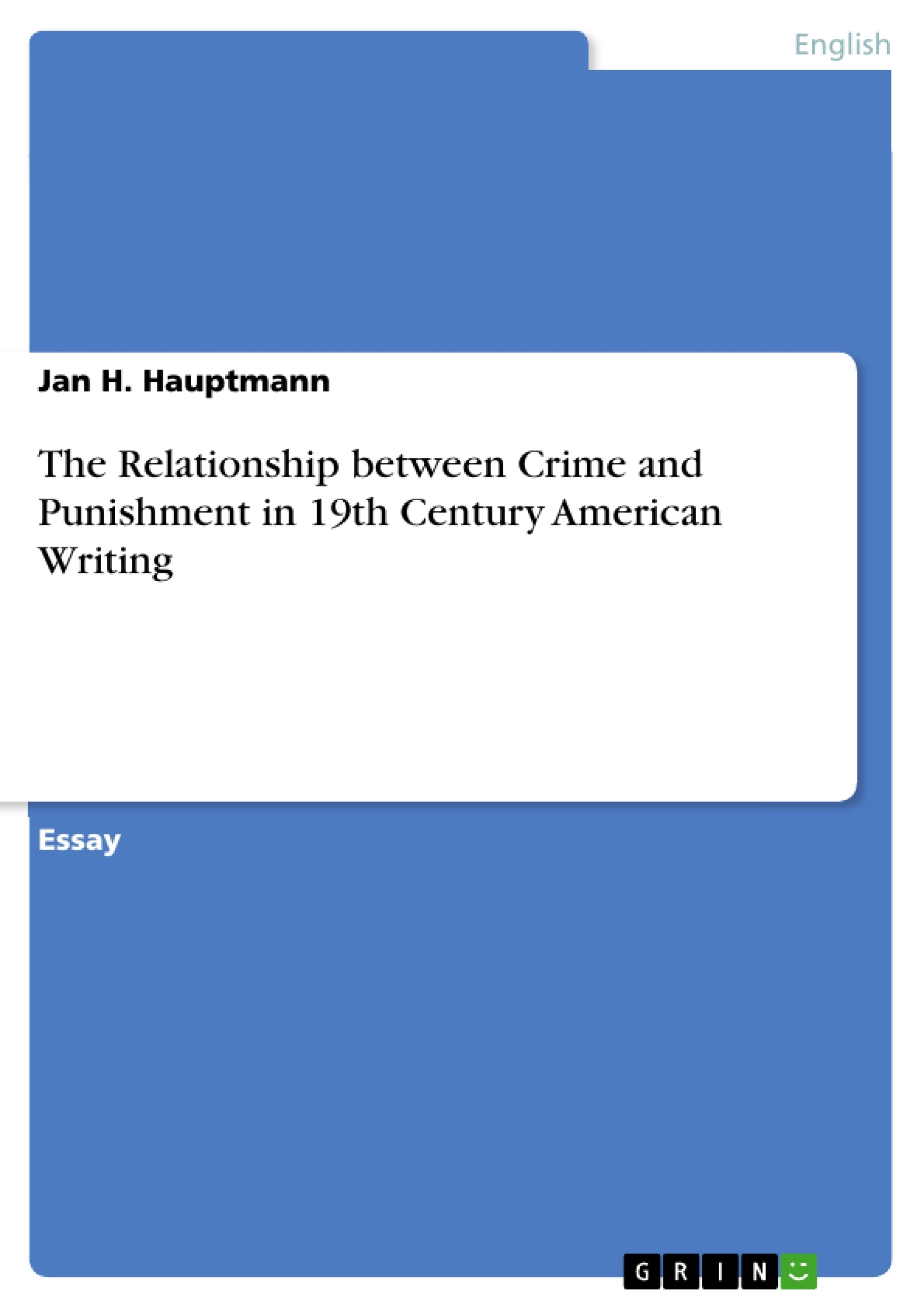This essay focuses on three American literary works of the 19th century: Nathaniel HAWTHORNE’s famous novel The Scarlet Letter was published in 1850, Herman MELVILLE’s short story Benito Cereno in 1855, and Mark TWAIN’s Pudd’nhead Wilson between 1893 and 1894. While the younger works Benito Cereno and Pudd’nhead Wilson are obviously concerned with the interrelation of blacks and whites, as well as with slavery and its effects on the American society, The Scarlet Letter primarily deals with the Puritan way of life and the law system in New England. Although a direct comparison of the three works seems to be problematical due to their different subject matters, the essay will figure out how crime and punishment is depicted in their broader frame.
HAWTHORNE’s Scarlet Letter is set in the 17th century in Salem, Massachusetts – the stronghold of New England’s Puritanism. The main character of the novel, Hester Prynne, is mother of an illegitimate child (Pearl) and thus a sinner that, according to the strict Puritan laws, has to be ostracised and punished. Her actual punishment is determined by the town’s magistracy and consists in the duty to carry a scarlet letter A on her clothes. The adulteress is also presented to an assembly of townspeople on the scaffold of the pillory. Midst of the crowd that is mocking the sinner is Hester’s missed husband – Roger Prynne – as well as the person whom she committed adultery with – the Reverend Arthur Dimmesdale. Ironically enough, Dimmesdale is regarded as an extraordinary exemplary Puritan priest by both, the townspeople and the town’s magistracy . His guilt remains undiscovered until the end of the novel.
Roger Prynne is a stranger at the beginning, who unexpectedly appears at the market-place out of the wilderness . When Hester spots him on the scaffold, he signalises her not to reveal his identity as her husband and starts an indirect inquiry about her, trying to figure out why she is set up to public shame. A townsman congratulates the newcomer to be back in civilisation after being “a wanderer sorely against [his] own will” and explains what had happened in town and why Hester Prynne is punished on the scaffold.
Inhaltsverzeichnis (Table of Contents)
- The Scarlet Letter
- The Punishment of Hester Prynne
- The Vengeance of Roger Chillingworth
- Dimmesdale's Guilt and Illness
- Chillingworth's Torment
- Hester's Redemption
- Dimmesdale's Hypocrisy
- Escape to Europe
- Dimmesdale's Death
- Hawthorne's Critique of Puritanism
- Benito Cereno
- Pudd'nhead Wilson
Zielsetzung und Themenschwerpunkte (Objectives and Key Themes)
This essay examines the portrayal of crime and punishment in three prominent 19th-century American literary works: Nathaniel Hawthorne's *The Scarlet Letter*, Herman Melville's *Benito Cereno*, and Mark Twain's *Pudd'nhead Wilson*. While focusing on the distinct societal contexts and moral dilemmas of each work, the essay aims to reveal how crime and punishment are depicted within their broader frames.
- The hypocrisy of Puritan society
- The consequences of sin and guilt
- The nature of justice and vengeance
- The effects of slavery on American society
- The complexities of race and identity
Zusammenfassung der Kapitel (Chapter Summaries)
The Scarlet Letter
The novel begins with the public punishment of Hester Prynne, a woman condemned for adultery and forced to wear a scarlet letter "A" on her clothing. The arrival of her estranged husband, Roger Chillingworth, introduces a vengeful force that seeks to unravel the identity of Hester's lover, Reverend Arthur Dimmesdale. While Dimmesdale struggles with his hidden guilt and the consequences of his hypocrisy, Chillingworth, disguised as a physician, seeks to torment him. Hester, however, experiences a gradual redemption through her acceptance of her punishment and her commitment to societal good. Ultimately, Dimmesdale succumbs to his internal turmoil and confesses his sin, leading to his death. Through this story, Hawthorne critiques the Puritan society for its hypocrisy and its inability to provide true redemption.
Benito Cereno
This short story focuses on a slave rebellion aboard a Spanish trading ship named the *San Dominic*. Captain Delano, the captain of a sealing ship, encounters the *San Dominic* and offers assistance. However, Delano's naiveté and misinterpretations of the situation contribute to a deceptive calm on the ship. The story ultimately reveals the intricacies of power dynamics and the insidious nature of slavery, leaving the reader to ponder the true motives and identities of the characters. The story's ending is marked by a dramatic climax where the power dynamics are disrupted and the slaves seize control, leaving a lasting impact on the reader.
Schlüsselwörter (Keywords)
This essay explores key themes related to crime and punishment in 19th-century American literature. The analysis focuses on the complexities of law, morality, and justice, examining the social and political landscapes of Puritan New England, the institution of slavery, and the emergence of racial tensions. The exploration of these themes through literary analysis reveals the authors' unique perspectives on the American experience and its profound moral dilemmas.
- Quote paper
- Jan H. Hauptmann (Author), 2007, The Relationship between Crime and Punishment in 19th Century American Writing , Munich, GRIN Verlag, https://www.grin.com/document/118350



